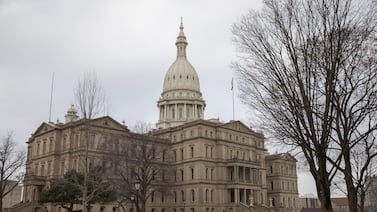Sign up for Chalkbeat Detroit’s free daily newsletter to keep up with the city’s public school system and Michigan education policy.
Michigan lawmakers passed a $23.4 billion state school budget Thursday that increases funding to support students from low-income families, English language learners, and the expansion of free prekindergarten. But it significantly cuts funding for mental health and school safety, leaving education leaders predicting devastating consequences.
Some advocates said the budget is a win for vulnerable student populations – and builds on previous progress in more equitably funding Michigan schools – but it does not include an increase to minimum per-pupil funding, which educators fear could lead to cuts and layoffs at schools across the state. It does, however, give some savings to school systems by reducing the amount of money they must pay into the retirement system.
“Overall, this is a tighter budget this year than the last couple,” said David Arsen, a professor emeritus of education policy and K-12 educational administration at Michigan State University. “But this budget does continue progress.”
The foundation allowance of per-pupil funding will remain the same at $9,608 per student.
Lawmakers and Gov. Gretchen Whitmer said the retirement savings for districts will offset the flat per-pupil spending.
The budget provides $589 million to offset districts’ payments into the Michigan Public School Employees’ Retirement system. This saves districts an amount roughly the equivalent $400 per student, according to the governor’s office.
“The amount associated with the reduction in districts’ MPSERS obligations increases the discretionary funds available above what was in the executive recommendation for the per-pupil increase,” said Arsen.
With the extra funds, Arsen said it won’t be likely districts will have to make cuts to the budgets they already approved based on the governor’s initial proposal. But individual districts, especially those with declining enrollment and those that used COVID relief money for recurring costs, will have challenges, he added.
The budget decreases per-pupil grants for mental health and school safety by well over 90%, said Robert McCann, executive director of the K-12 Alliance of Michigan. That cut sent shockwaves through the education community on Wednesday, when news of the cut first surfaced.
The new budget includes $25 million for the grants, compared to $328 million in the previous budget.
Livonia Public Schools Superintendent Andrea Oquist told Chalkbeat Wednesday that the cut would reduce the $3 million it received to provide extra psychologists, social workers, security personnel, and security cameras to $225,000.
“That is a devastating cut to every school in the state for a variety of programs that are directly designed to not only keep students safe, but healthy. We know that’s critically important to their success in the classroom,” McCann said Monday. “It’ll vary from district to district in terms of the significant impact it will have. But it’s safe to say that the effect will be profound.”
The budget gives a total of $1 billion for programs to support students from low-income families – the highest amount ever allocated to such programs.
The money will be distributed to districts through the state’s “opportunity index,” a funding formula created last year that gives more money to districts serving communities with higher concentrations of poverty. Previously, the same amount of per-pupil funding was given to students considered to be “at-risk” by the state.
“Additional investments in the Opportunity Index are critical to right the past wrongs and ensure that students with the greatest needs in Michigan – Black and Latino students, students from low-income backgrounds, English Learners, and students with disabilities – have every opportunity to reach their highest potential,” said Alice Thompson, chair of the education committee of the NAACP Detroit branch, in a statement.
For years, advocates have asked lawmakers to make education funding more equitable in Michigan. Historically, the state has been among the worst in the nation for gaps in funding between impoverished and wealthy communities.
Groups such as Education Trust-Midwest, have asked legislators to commit in the next five years to a total of $2.9 billion in additional funding through the Opportunity Index for at-risk students.
The legislation allows districts who receive the funds to use up to 30% of the money to reduce teacher-student ratios in K-3 classrooms and an additional 30% to be used for teacher recruitment and retention at some schools.
Ed Trust-Midwest has advocated for the state to add more transparency and accountability for districts to report how they spend at-risk dollars.
“This was a missed opportunity,” said Mike Jandernoa, a chair of the Michigan Partnership for Equity and Opportunity, a coalition that advocates for equity in school funding. “It is critical that the state create a strong new system of transparency for increased Opportunity Index spending. That includes ensuring that resources targeted for students with the greatest needs actually reach their schools.”
A recent analysis by the Citizens Research Council of Michigan found that only 55% of the state’s largest school districts showed patterns of equitable per-pupil spending with state dollars, despite an increase in at-risk funds in recent years.
Support for English language learners increased by 26%, totalling $50.2 million in funding. Advocates said this builds on the progress made by lawmakers last year, when the budget for English language learners increased by 90%.
Even with the progress made last year, Michigan still ranked among the worst in the nation compared to other states in the percentage of funding allocated to support English language learners in 2023, according to Ed Trust Midwest.
Though the budget provides $130 million in investments to expand free pre-K – which will be offered universally in the state two years ahead of previous plans – it still falls short of the goal in the governor’s proposal.
The funds will help serve around 5,300 more 4-year-olds, open new classrooms in underserved areas, pay for student transportation, and increase per-child allocations for attending a full day of pre-K to $10,185.
The legislation does not include language advocacy groups warned would force early child care programs to close.
A previous House budget proposal would have taken out language that ensured 30% of funding for the Great Start Readiness Program, the state’s free preschool program, go to community-based or private providers. A previous Senate proposal would have made private GSRP programs pay at least the average salary of other GSRP teachers in their regions.
The budget also pays for free admission to community college for all Michigan residents.
The budget makes $50 million in one-time funding for after-school and summer school programs ongoing and gives an additional $25 million in one-time funding. The advocacy group Michigan Afterschool Partnership estimates that the funding will benefit 75,000 youth this year.
Other budget highlights include: continued free breakfast and lunch for all K-12 public school students and continued transportation cost reimbursements for districts.
The approved school budget will now go to the governor’s desk to be signed. She may veto some or all of the bill.
The final budget will go into effect Oct. 1.
Hannah Dellinger covers K-12 education and state education policy for Chalkbeat Detroit. You can reach her at hdellinger@chalkbeat.org.
Correction: July 1, 2024: A previous version of this story incorrectly reported that the Michigan school aid budget approved June 27 did not cut funding for mental health and school safety grants. The funding for those two programs was significantly reduced in the budget.






